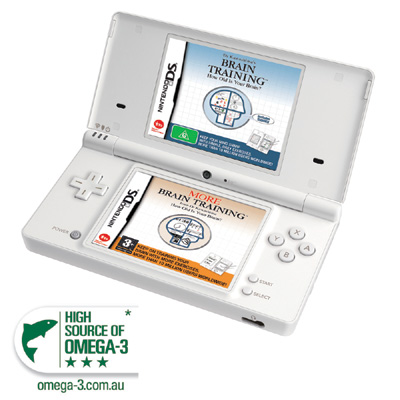
1 lucky winner has the chance to win a Nintendo DS and Brain Training pack, valued at $398.90 thanks to the new Omega-3 Fish Scale.
Look for the Omega-3 Fish Scale on John West and Birds Eye packs for an easy way to keep track of your Omega-3 intake.A new Newspoll survey1 has revealed that nine out of ten Australians know that fish is the best natural source of omega-3; however, the majority are unaware that different fish have significantly different levels of omega-3, which could affect their purchasing decisions when looking to buy the richest sources of omega-3.
Research from Food Standards Australia New Zealand and other organisations2 shows that Australia's three most popular types of fish - barramundi, tuna, and dory - all have significantly lower levels of long chain omega-3 EPA and DHA (190mg, 250mg and 490mg respectively, per 100g serve) than oily fish like sardines, red salmon and mackerel (2510mg, 1970mg and 1930mg respectively per 100g serve) which are some of the richest natural sources of long chain omega-3.
The Newspoll survey revealed:
· Only a fifth (21 per cent) of Australians are aware that sardines have the highest level of naturally occurring omega-3.
· Nearly a quarter (23 per cent) incorrectly think tuna is the best source of naturally occurring omega-3 .
In response to this confusion amongst consumers, leading seafood brands John West and Birds Eye are making it easy for shoppers with the new Omega-3 Fish Scale.
The Omega-3 Fish Scale is a rating system that helps to quickly and easily identify the levels of omega-3's EPA and DHA in each product. The more stars on the Fish Scale, the more omega-3 there is in the fish you have chosen. There are three levels - Source, Good Source and High Source. Check the nutrition information panel on pack for the omega-3 EPA and DHA content of products.
The Heart Foundation recommends that healthy adults have 500mg of omega-3's EPA and DHA per day for heart health3. They also suggest that we should eat two to three serves of oily fish or seafood every week.
Omega-3s are unique fatty acids that are essential for growth, development and ongoing health from birth to old age. In particular, long chain omega-3's EPA and DHA help to promote brain function, maintain a healthy heart and good eyesight. As the body can't produce enough long chain omega-3s for our requirements, it is important to ensure that we include them in our daily diets, preferably in their most natural form.
Fish is one of the most versatile foods to incorporate into your diet. And with many chilled, canned and frozen varieties available, they are a quick and easy alternative to fresh fish to ensure you are getting enough long chain omega-3 in your diet.
1 Newspoll survey was conducted 14-16 May 2010 on the Newspoll Telephone Omnibus amongst a nationally representative sample of 1200 respondents aged 18 years and over.
2Omega-3 Comparison Chart sourced from:
· Food Standards Australia New Zealand. NUTTAB 2006. Online database of the Nutritional Composition of Australian Foods. Canberra: FSANZ, 2006.
· MLA. The role of red meat in healthy Australian diets. 2007.
· AECL . Nutritional information research study October - November 2007.
· Nichols PD et al. Seafood the good food. 1998.
· Sinclair AJ et al. The ?-3 fatty acid content of canned, smoked and fresh fish in Australia. Aust J Nutr 1998; 55:116-120.
· McCance and Widdowson's The Composition of Foods integrated dataset (CoF IDS). http://www.food.gov.uk/science/dietarysurveys/dietsurveys/ (accessed 30/09/09).
3 National Heart Foundation of Australia 2008.
http://www.heartfoundation.org.au/sites/HealthyEating/understandingfatsandcholesterol/Pages/Aguidetofishandomega-3.aspx



